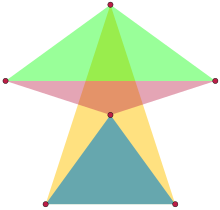In discrete geometry, an isosceles set is a set of points with the property that every three of them form an isosceles triangle. More precisely, each three points should determine at most two distances; this also allows degenerate isosceles triangles formed by three equally-spaced points on a line.

History edit
The problem of finding the largest isosceles set in a Euclidean space of a given dimension was posed in 1946 by Paul Erdős. In his statement of the problem, Erdős observed that the largest such set in the Euclidean plane has six points.[1] In his 1947 solution, Leroy Milton Kelly showed more strongly that the unique six-point planar isosceles set consists of the vertices and center of a regular pentagon. In three dimensions, Kelly found an eight-point isosceles set, six points of which are the same; the remaining two points lie on a line perpendicular to the pentagon through its center, at the same distance as the pentagon vertices from the center.[2] This three-dimensional example was later proven to be optimal, and to be the unique optimal solution.[3][4]
Decomposition into 2-distance sets edit
Kelly's eight-point three-dimensional isosceles set can be decomposed into two sets (the three points on a line perpendicular to the pentagon) and (the five vertices of the pentagon), with the property that each point in is equidistant from all points of . When such a decomposition is possible, in Euclidean spaces of any dimension, and must lie in perpendicular subspaces, must be an isosceles set within its subspace, and the set formed from by adding the point at the intersection of its two subspaces must also be an isosceles set within its subspace. In this way, an isosceles set in high dimensions can sometimes be decomposed into isosceles sets in lower dimensions. On the other hand, when an isosceles set has no decomposition of this type, then it must have a stronger property than being isosceles: it has only two distances, among all pairs of points.[5]
Despite this decomposition theorem, it is possible for the largest two-distance set and the largest isosceles set in the same dimension to have different sizes. This happens, for instance, in the plane, where the largest two-distance set has five points (the vertices of a regular pentagon), while the largest isosceles set has six points. In this case, the six-point isosceles set has a decomposition where is the singleton set of the central point (in a space of zero dimensions) and consists of all remaining points.[5]
Upper bounds edit
In -dimensional space, an isosceles set can have at most
but these numbers are not known for higher dimensions.[7]
Construction edit
Lisoněk provides the following construction of two-distance sets with
Generalization edit
The same problem can also be considered for other metric spaces. For instance, for Hamming spaces, somewhat smaller upper bounds are known than for Euclidean spaces of the same dimension.[7] In an ultrametric space, the whole space (and any of its subsets) is an isosceles set. Therefore, ultrametric spaces are sometimes called isosceles spaces. However, not every isosceles set is ultrametric; for instance, obtuse Euclidean isosceles triangles are not ultrametric.[8]
References edit
- ^ Grossman, Howard; Thebault, Victor; Schell, E. D.; Scheffe, Henry; Erdős, Paul (August 1946), "Problems for Solution: E731–E735", The American Mathematical Monthly, 53 (7): 394, doi:10.2307/2305860, JSTOR 2305860. See in particular problem E735.
- ^ Erdős, Paul; Kelly, L. M. (April 1947), "E735", The American Mathematical Monthly, 54 (4): 227, doi:10.2307/2304710, JSTOR 2304710
- ^ Croft, H. T. (1962), "9-point and 7-point configurations in 3-space", Proceedings of the London Mathematical Society, Third Series, 12: 400–424, doi:10.1112/plms/s3-12.1.400, MR 0155230
- ^ Kido, Hiroaki (2006), "Classification of isosceles eight-point sets in three-dimensional Euclidean space", Electronic Journal of Combinatorics, 27 (3): 329–341, doi:10.1016/j.ejc.2005.01.003, MR 2206471
- ^ a b c Blokhuis, A. (1983), "Chapter 7: Isosceles point sets", Few-Distance Sets (Ph.D. thesis), Eindhoven University of Technology, pp. 46–49, doi:10.6100/IR53747, Zbl 0516.05017
- ^ a b Lisoněk, Petr (1997), "New maximal two-distance sets", Journal of Combinatorial Theory, Series A, 77 (2): 318–338, doi:10.1006/jcta.1997.2749, MR 1429084
- ^ a b Ionin, Yury J. (2009), "Isosceles sets", Electronic Journal of Combinatorics, 16 (1): Research Paper 141, 24, doi:10.37236/230, MR 2577309
- ^ Fiedler, Miroslav (1998), "Ultrametric sets in Euclidean point spaces", Electronic Journal of Linear Algebra, 3: 23–30, doi:10.13001/1081-3810.1012, MR 1615350